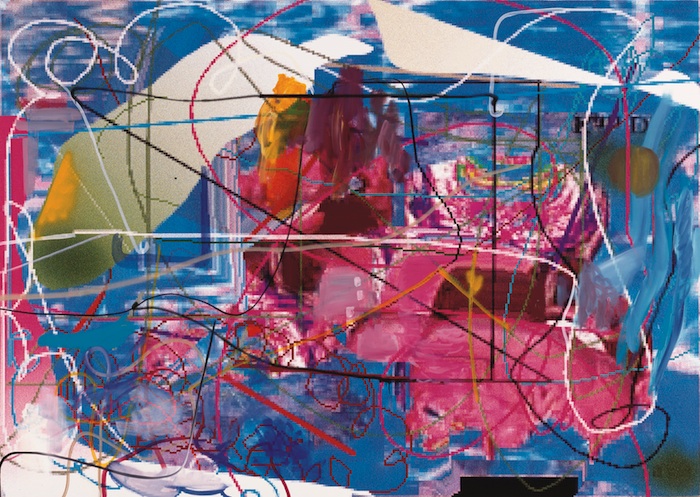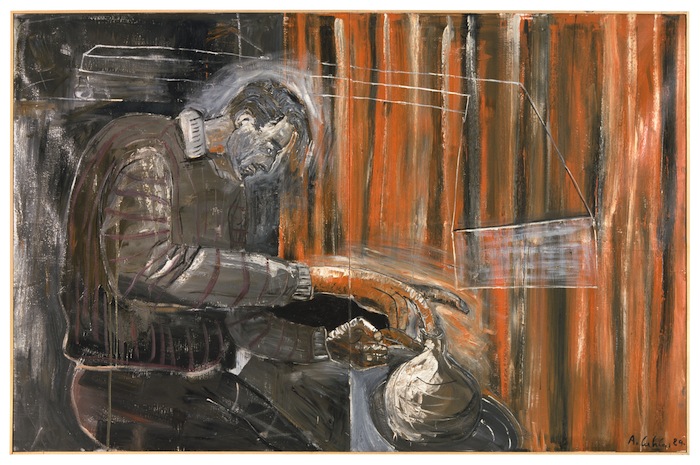From Brushstroke to Keystroke and Back Again: Six Artists Talk Contemporary Painting at the New Museum

Albert Oehlen, Streithelfer, 1997, oil on canvas.
GAGOSIAN GALLERY/COURTESY THE ARTIST AND GALERIE MAX HETZLER, BERLIN
“None of the terms of painting really make sense to me,” the artist Molly Zuckerman-Hartung said on Saturday at the New Museum’s contemporary painting symposium, held in honor of its current Albert Oehlen survey. “Painting has a lot of baggage. Terms like ‘zombie formalism’ grate at me.” At some point or another, all five of the day’s other artist-panelists concurred.
Zuckerman-Hartung sat alongside Josh Smith and Mika Tajima at the first of two panels that afternoon. Its subject was contemporary abstraction, which is a fairly abstract topic, the artists agreed. “The notion of abstraction is contradictory, actually,” said Tajima, who called herself a sculptor involved with painting. “If something is abstract, it’s indescribable with language. And the idea of painting itself is a ridiculous way of thinking about abstraction because if you’re materializing something or putting it into language, you’re already doing something that isn’t abstract.” Tajima’s psychedelic office furniture–inspired works deal with the “intersection of information, social space, and history,” as she put it. She uses the surface of cubicles to address those three topics, and she discussed her work in terms of economics.Smith was a bit more plainspoken. When the panel’s moderator, Maria Lind, director of the Testa Konsthall in Stockholm, asked him about the scrappy monochromes he showed at Luhring Augustine in New York two years ago, he kept it simple. “Well, actually, imagine, like, a square that’s about four feet tall and five feet wide. It’s, like, one color or something?” he said, and left it at that.Zuckerman-Hartung said she came to abstract painting after studying literature and writing. She had a “discovery of fervent belief” when she read Mondrian’s writings. “It has everything to do with this weird headspace that abstraction can produce,” she said. “It’s also a shared language.”“I don’t know if I’m on the right panel,” Smith said after Tajima and Zuckerman-Hartung swapped ideas about gender, economics, and ethnicity in abstraction. “I don’t think you have to explain abstraction at all,” he said. “Just in the last 30 to 40 minutes, I’ve thought more about it than I ever have. It’s just about using your being to get in there for a second.”Zuckerman-Hartung was curious about Smith’s reaction, especially after Smith talked around whether abstraction and masculinity still had anything to do with one another, and the conversation became tense. Ultimately, though, she and Smith agreed that abstraction broaches something bigger than us. “It’s up to people to transcend what’s available to them in their lifetime,” Smith said.One audience member wanted to know: is there a concrete definition of abstraction? “I have no positive definition of abstraction,” Zuckerman-Hartung told him. “I would never want to have a positive definition of anything!”

Albert Oehlen, Selbstportrait mit Einlochtopf, 1984, oil on canvas.
COURTESY THE ARTIST AND GALERIE MAX HETZLER, BERLIN/COLLECTION OF LIZ AND ERIC LEFKOFSKY
After a half-hour break, Ken Okiishi, Florian Meisenberg, and Kerstin Brätsch gathered to discuss digital abstraction. Okiishi began by presenting a Frieze project he made in 2013, in which a robot shot paintballs onto a glass surface and canvases when visitors pressed a button. (“I’m particularly allergic to the art-fair context, seeing all the people fucking each other,” he said as he played video documentation of the project.)
Okiishi later explained that his art began with a joke: the grease left behind from fingerprints on screens is actually the result of abstract gestures. Anyone with an iPhone can become Pollock. But then, for Okiishi, it became something more—it became “generative,” as he put it, and he was able to use painting to blur the inside and outside of screens. By painting on top of screens and then filming those painted screens, he was, quite literally, turning digital technology inside out—he was putting gestures that are normally made on top of screens inside them.Like Okiishi, Meisenberg combines analog and digital techniques for his paintings. For a show earlier this year at Simone Subal Gallery, Meisenberg made a 21-foot-long painting that involved squirted-out oil paint, imprints from his buttocks, and memory cards. “My artistic approach derived from painting,” Meisenberg said, “but I’m consistently engaged with the digital sphere.”Meisenberg, who studied painting with Peter Doig, spoke about how technology has inundated us with images, creating what he called a “jet lag of meaning.” In response, a video in that Simone Subal show featured an amorphous digital blob engulfing and regurgitating sculptures, furniture, and other objects.Digital technology’s ability to layer images came up again when Brätsch discussed the relationship of language to painting. Brätsch said she had “abstract anxiety,” and that she wanted, at first, to get away from it. “To shatter [abstraction], I must drop it, so to drop it, I must drop a drop of paint,” she said. This resulted in her digitally designed, geode-like forms, which feature swirling forms that seem to be layered. The point, she said, was to get people talking—to bring up the pile-up of history in these images, which recall Renaissance marble sculptures and cracked computer screens simultaneously. It was, as Brätsch put it, “painting as pot-stirring.”When the panel’s moderator, media theorist Alexander Galloway, asked whether there was anything spiritual in her images, Brätsch paused for a while and thought it over. “It’s just kind of hard to describe that with language,” she concluded.Okiishi was more straightforward: there is no spiritual content to his work. “Maybe it’s just, ‘Oh, I’m working on something,’” he said of his process. Then, realizing that the conversation had veered far away from its original topic, Okiishi said, “I had this impression that we were here to discuss digital painting, and then it became something else.”“I wonder what Oehlen would say,” Brätsch responded.
Source: www.artnews.com
Copyright 2015, ARTnews Ltd, 40 W 25th Street, 6th Floor, New York, N.Y. 10010. All rights reserved.